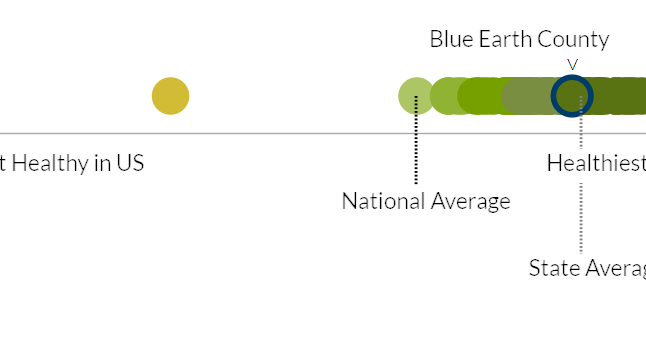
#inform-video-player-1 .inform-embed { margin-top: 10px; margin-bottom: 20px; }
#inform-video-player-2 .inform-embed { margin-top: 10px; margin-bottom: 20px; }
MANKATO — New health rankings released this year show gulfs between counties in south-central Minnesota, although all nine are above average in key metrics compared to national averages.
The annual County Health Rankings and Roadmaps data release from the University of Wisconsin Population Health Institute, supported by the Robert Wood Johnson Foundation, measures health outcomes and health factors. The former is a measure of length and quality of life, while the latter is a predictive measure of future health.
Nicollet County fared best in south-central Minnesota, ranking 12th out of 87 counties in health outcomes and ninth in health factors. Blue Earth County ranked 33rd and 18th, respectively, in the measures.
Watonwan County had the lowest health factors placement in the region, ranking 78th. Higher than average uninsured, smoking and obesity rates contributed to the low ranking, although it placed 36th in actual outcomes.
Faribault County had the lowest rank, 60th, in health outcomes. This equated to a life expectancy two years shorter than Nicollet County’s — 78.7 versus 80.7. Its health factor rank was 46th.
Faribault County and Martin County — which ranked 20th and 57th in the metrics — share a health and human services department. The COVID-19 pandemic exacerbated health issues identified as priority areas in community assessments, said Chera Sevcik, executive director.
The assessment in 2019, performed at least every five years by county public health agencies, identified substance use and mental health issues to focus on in the counties. Another assessment in 2022 showed the same, Sevcik said, and the agency continues to work on them with community partners.
“We’re investing in community work to really look at how do we address those issues we knew about before the pandemic,” she said.
No longer needing to organize large scale COVID-19 vaccination clinics and more pandemic responses makes other work more feasible now.
“With the pandemic emergency response calming down, we’re able to dedicate resources back to working on some of those priority issues that may have gotten worse over time,” Sevcik said.
The pandemic made public health work much more visible than it typically is. Many residents turned to them for case updates, tests, vaccines and general information during a rapidly changing situation.
Public health agencies remain hard at work on community issues, Sevcik said, it’s just more under the radar.
Area counties’ above-average ratings when compared to national averages speak to how relatively healthy Minnesota is compared to other states. The data showed Minnesotans live longer, are more physically active and have more access to physicians than average.
In an announcement on the new data in March, the report’s authors pointed out two other attributes tied to healthier counties: broadband and public library access. Counties investing in ways to “participate in civic activities and provide ample information sources”
“Improving civic health requires action,” stated Bethany Rogerson, co-director of the County Health Rankings & Roadmaps, in a release. “We can invest in ways for people to connect, value their participation, and, ultimately, influence how and whether we thrive. We can and should all have a say in our communities’ futures.”
To see your county’s rankings, go to countyhealthrankings.org/health-data.
Follow Brian Arola @BrianArola
#inform-video-player-3 .inform-embed { margin-top: 10px; margin-bottom: 20px; }
